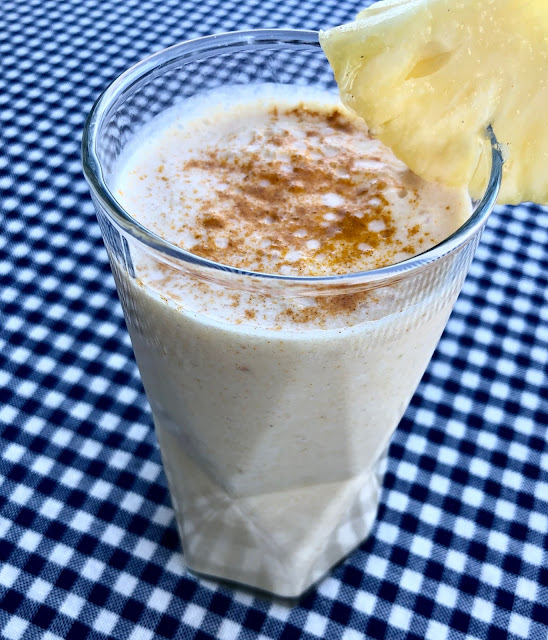One of the habits that I've changed since I started following Hannah Freese, RD's diet is to be sure and eat a high fat breakfast. Her meal plans start you off on all kinds of delicious high fat breakfasts which I have no complaints about at all. Her diet has five steps and I'm currently on Step 4 where you reset your appetite control center which is your brain. In other words, we are learning why we eat and learning how to stop eating for emotional reasons and learn to eat for nutritional reasons only. This is a three week process. Her diet is really a full on course, not just a diet. There is so much to relearn! The fact that I was trained as a dietitian and worked in the field for 35 years makes it almost harder for me because she is telling us to do so many things I would have NEVER told my patients to do. I've been retired for five years but I can't believe how much has changed. Eating high fat? Gasp! Do not restrict salt? Never! Sugar causes heart disease? What? Load up on natural saturated fat? Really? And the weird part? I'm loving every minute of it! I've been enjoying all my meals and I'm losing weight and inches. This smoothie recipe has been one of my favorites. It's like drinking a pina colada for breakfast! (without the rum) The high fat ingredient in this is the full-fat coconut milk. We use a lot of full-fat coconut milk in her diet and I don't mind it at all. I know coconut milk is popular with paleo diets and as a dietitian, we always thought it was bad because it's a saturated fat and saturated fats have always been a bad fat. But times have changed. The fat in coconut oil are MCT or medium-chain triglycerides that go through your intestinal wall, straight to the liver that burns for energy, not stored as fat. So, if you're going to eat fat, eat MCT. We use to give it to patients who had malabsorption problems and it was real expensive and tasted horrible if you had to take it orally. But it's naturally in coconut milk. I've been buying the coconut milk at Trader Joe's that doesn't have any added thickeners or gums and is one of the kinds that Hannah recommends.
Hannah's diet involves modules that we go through at each step and there are videos to watch that are very helpful. We also have a zoom meeting every week where we can ask our questions and have really good discussions about her diet plan. I've actually gone through all the recipes on my blog now and labeled the ones that qualify as "The Freese Method" diet. Tonight, we are having my crockpot chicken fajitas. I won't be eating the tortillas that go with them but Bruce will definitely be enjoying his. You can be sure that I'll be piling on the avocado, cheese and sour cream, though! When it comes to carbs, Hannah's diet is based on not spiking our insulin secretion so carbs/sugar are the worse for spiking insulin. That's why we avoid most carbs and eat more fat. We don't completely eliminate carbs because many fruits are included in the diet as well as beans, legumes, vegetables and sweet potatoes which makes it different from the keto diet. She explains it by saying that we all have a carbohydrate budget. When our metabolism is broken, we have a very small budget. Our budget increases as our metabolism is repaired. So, eventually, I'll be able to handle more carbs once I get to my goal weight. It seems like the carbs that I've craved have been fruits which she allows and I don't even miss bread and pasta anymore. The other good thing about her diet is that she progresses us in steps so it gets easier and easier. Now that I'm on Step 4, I don't even feel like eating snacks anymore and I've shortened my eating window a lot and feel perfectly fine about it. It's because her meal plans gradually wean us out of our bad eating habits and into her "Freese Method" of eating. When I saw a chocolate bar with a fresh orange or with nuts for my evening snack in the Quick Start and Step 1, I was like "I can do this diet!" Anyway, it's all been very interesting to me as a fellow dietitian and as one who always loves to analyze the endless mystery of the food we eat.
1 cup organic, full-fat canned coconut milk


Hi Sylvia! I need to thank you for this post. I know it's a few years old and I've seen it before, and it was good to 'find' it again. I was on Hannah's program, I lost weight, then slowly allowed the carbs back in....and you can guess the rest. Starting over now, I've barely budged over the past 6 weeks, and in re-reading this last night, I thought this sounded yummy. When I woke up this morning, I had an epiphany. I wasn't eating enough fat! Especially in the morning. So I'm drinking my smoothie and typing this, and rethinking my approach.....again! Thanks! Are you in her alumni program?
ReplyDeleteI was in her alumni program until she discontinued her program. But I continue to follow her guidelines to this day. Keep going! You can do it.
ReplyDelete